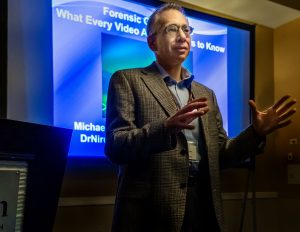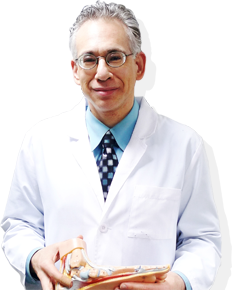Forensic Gait Analysis and Forensic Gait Comparison
Criminal gait comparison or forensic gait analysis (as it is commonly called) involves evaluation of features of gait (the manner that a suspect or person walks or runs) and comparing those gait features (or a combination of those features) to those of a criminal walking or running (often captured on surveillance video footage or CCTV).
As a forensic podiatrist, Dr. Nirenberg is a forensic gait expert who is available for cases in the United States (USA), Canada and worldwide. He has expertise linking (and unlinking) criminals captured on video (often walking) to that of suspects or other persons by comparing features of their gait (their style or manner of walking).
Forensic gait analysis has been defined as the analysis, comparison and evaluation of features of gait to assist the investigation of crimeGait analysis may provide assistance in convicting a criminal, exonerating a wrongly accused individual or assisting in eliminating a person of interest (or providing additional evidence of wrongdoing by a person of interest).
Understanding Forensic Gait Analysis
Forensic gait analysis or forensic gait comparison falls into the field of forensic podiatry and biomechanics. Gait refers broadly to the style or manner that people walk or run and typically gait in forensic cases refers to the features of how a criminal walks or runs (often during a criminal act, at a crime scene or associated with criminal activity).
 Dr. Nirenberg was a co-editor and a co-author of the textbook Forensic Gait Analysis: Principle and Practice, published by CRC Press of the Taylor & Francis Group.
Dr. Nirenberg was a co-editor and a co-author of the textbook Forensic Gait Analysis: Principle and Practice, published by CRC Press of the Taylor & Francis Group.
Here are news stories about Dr. Nirenberg’s forensic gait analysis assisting with criminal investigation:
http://whnt.com/2018/02/27/gait-closed-how-a-suspects-walk-cracked-a-cold-case-robbery/
While gait has been used in criminal matters in the USA since the early 1900s, forensic gait analysis in its current form is relatively new. Forensic gait analysis is underpinned by a gait “tool” which has been tested, peer-reviewed and published.
Forensic gait analysis may assist with comparison of criminal seen walking or running (on surveillance video footage or CCTV) while performing a criminal act, such as a robbery, assault, murder and so on. While gait in the context utilized for forensic gait analysis is not unique, the findings of the gait analyst may provide important supporting evidence for including or excluding a suspect in a criminal investigation.
There may also be civil cases where the way the person in question walks may be relevant to the judge or jury.
Forensic gait analysis is an often overlooked piece of video evidence in America, though gait has been used in dozens of cases in the United Kingdom. In addition to helping to compare criminal caught on video (CCTV) to a suspect, forensic gait analysis may provide information that assists in showing that the same individual was involved in two or more criminal acts at different locations and/or at different times. Information that assists in linking (or unlinking) an unknown perpetrator caught on video (CCTV) to more than one criminal act by their gait–their style of walking or running–may be useful in helping to solve the crimes or link the crimes together. Dr. Nirenberg is available to assist on forensic cases involving footprints, feet and gait (on video) in the USA, Canada and worldwide.
Analysis of Criminal Walking or Forensic Gait Analysis at Crime Scenes
Today in America the use of video cameras for surveillance (CCTV video) of businesses and personal property is widespread and as a result criminals may be seen on video footage walking or running while in the act of performing a crime or while walking to or from the scene of the crime.
To utilize forensic gait analysis or gait comparison, a suspect is necessary for comparison. Investigators should be aware that the criminal captured on surveillance video (CCTV) may have visited the crime scene earlier in the day or in the days prior to the criminal act and this earlier video footage may reveal a person of interest. Should a person of interest be identified in the earlier video footage, the gait of the person of interest and the criminal may be compared/analyzed.
Should investigators make an arrest based in part on how the criminal and suspect walk, an expert analysis of the suspect’s walk may be beneficial in helping the jury reach a conclusion that the criminal in the surveillance video and suspect walk with similar gait features (if this is the case). Defendant attorneys may wish to have the manner of walking of their client analyzed by an expert in cases where they believe their client’s gait differs from that of the criminal in question.
Dr. Nirenberg’s Forensic Podiatry and Forensic Gait Expertise
As a forensic podiatrist in the USA Dr. Nirenberg has used his expertise to link footprints and footwear to suspects and testified in court in these situations in the United States. His expert forensic podiatry testimony in U.S. courts has helped convict criminals in regard to their footprint or footwear, and he has assisted American investigators in analyzing distinctive features of suspects and criminals manner of walking.
http://hamptonroads.com/2014/08/detectives-turn-podiatry-help-solve-murder-case
Additional information about forensic gait comparison and analysis can be found in Police Chief Magazine –
Dr. Nirenberg is active in the American Society of Forensic Podiatry and served on the International Association for Identification’s Forensic Podiatry Subcommittee. His forensic articles have been published in Journal of Forensic and Legal Medicine, Science & Justice, Journal of Forensic Sciences, Journal of American Podiatric Medical Association, and the Journal of Forensic Identification. To learn more about him click here.
Dr. Nirenberg co-authored a scientific paper on forensic gait analysis – click here.
Brief History of the Use of Forensic Gait in United States Courts
In the United States the way or manner that a person walks has been the subject of courtroom testimony since 1908. In the case, which occurred in Texas, USA, a robbery victim testified that even though the criminal’s face was hidden, the victim knew him by his voice and “his walk” (see “A review of the historical use and criticisms of gait analysis evidence,” Science & Justice, 58(4), pp.292-298).
Today, experts in the USA. and elsewhere utilize a step-wise approach to analyzing how a criminal walks (forensic gait analysis) and then perform the same approach to the suspect’s manner of walking.
The initial act in the process is for forensic experts to evaluate the video footage with the criminal and suspect walking and make a determination if the surveillance video is adequate to perform a meaningful forensic gait analysis.
Forensic gait analysis and comparison of the way a criminal walks (or moves or runs) on video (CCTV) may be assistive to law enforcment in helping to rule in or rule out suspects, and investigators in the United States (or elsewhere) should feel free to request Dr. Nirenberg’s advice on how to best obtain surveillance video of suspects in criminal matters (ideally, prior to making an arrest)
Use Dr. Nirenberg’s Expertise for Forensic Gait Analysis or Comparison
Dr. Nirenberg recognizes that forensic gait analysis is simply one tool in the analysis of the evidence in a case and as such, he will work on analyzing the gait evidence alone or in conjunction with your team. He welcomes working with other forensic experts including forensic video analysts, other forensic video specialists, forensic photography experts and other gait experts.
If you have a matter related to gait in the USA (or elsewhere) in which the way the person in question walks – their gait – may be relevant, feel free to call or e-mail Dr. Nirenberg to discuss how forensic gait analysis or comparison may assist your case. Dr. Nirenberg can be reached at (219)663-2273 or Email Us.





